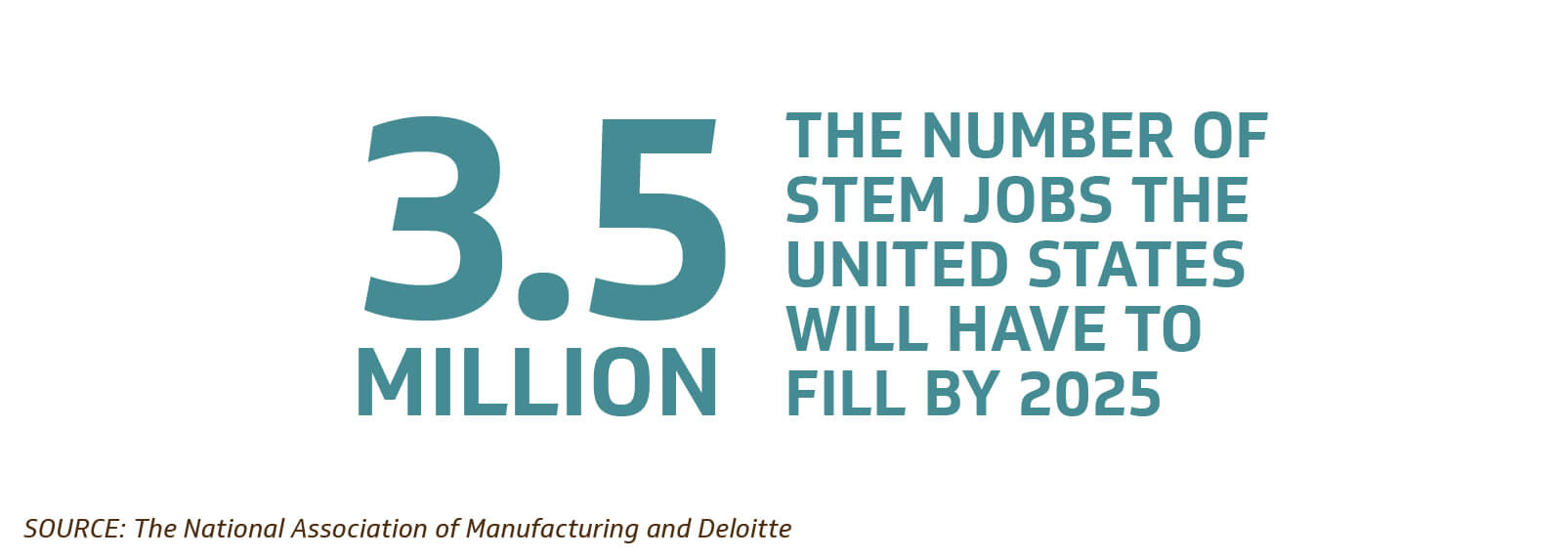
PUBLISHED AUGUST 20, 2019
3 Factors Driving the STEM Talent Gap
You’ve likely heard there is a growing STEM talent shortage. Employers across various industries face a tremendous talent crisis, causing business and innovation delays. And matters are projected to continue.
The current talent gap is driven by several interrelated factors that perpetuate the demand for quality STEM professionals. These drivers include:
1. Skills: Labor needs for innovation continue to rise, creating more STEM jobs. Despite the growth, there are unfilled jobs due to a shortage of available STEM professionals, resulting in additional business challenges.
2. Geography: Economics, policies and locations domestically influence concentrations of job seekers and STEM jobs, while the national supply of resources lacks in quantity compared to STEM professionals outside the United States.
3. Education: Current enrollment rates in postsecondary institutions fall short in producing STEM graduates alongside the widening STEM skills gap. Disinterest in STEM subjects among youth in secondary schools also perpetuates the current talent shortage.
Skills
With the growing demand to innovate, organizations across various industries struggle to fill skilled positions. It’s projected that there will be 3.5 million STEM jobs in the U.S. by 2025, and 2 million of those jobs will go unfilled, despite a national focus on STEM over the past decade.
Compounding this dilemma, shifting labor needs due to technology advancements have intensified a non-negotiable demand for skilled STEM professionals. Job growth in emerging technologies are generating more business and the development of new STEM roles.
The future of the STEM talent landscape is still somewhat obscure. Talent professionals are informed about today’s current climate and demand, but the jobs and skillsets of tomorrow are still a mystery due to rising technology and the rapid pace of innovation. In fact, data suggests that 65 percent of elementary school students today will participate in a future workforce with jobs that haven’t been invented yet.
Market drivers motivating this revolution include the Internet of Things, artificial intelligence, machine learning, augmented and virtual reality and blockchain. Alongside these emerging technologies, the physical location of skilled professionals further complicates the STEM talent gap.
Geography
While the demand for STEM professionals continues to grow, another dilemma presents itself—much of the global STEM talent exists outside the United States. In recent years, the nation fell in ranks to third place in the global production of STEM graduates, following behind China and India.
Domestically, geography also presents an additional challenge to STEM jobs. Economics, policy and local geography factors play a significant role. Geographic barriers also pose an issue of job access within areas of surplus STEM jobs. Many hubs of STEM jobs are physically further away from qualified job seekers, resulting in a need to import skilled talent from other regions despite having a local populace.
This equity dilemma is caused by a lack of opportunity to underserved communities fueled by poverty and place, undermining the fulfillment of a skilled workforce.
Job growth continues to concentrate in urban and metropolitan areas on U.S. coasts as postsecondary requirements for jobs, such as a bachelor’s degree, rise in trend. Alongside this upsurge, jobs are projected to steadily shrink across the Midwest and Southern regions by 2026, which have been widely affected by automation, globalization, labor outsourcing and industry departure.
Geographic barriers aren’t the only obstacle to filling jobs in the STEM Talent landscape—the lack of an educated STEM workforce also drives the current talent crisis.
Education
Teaching skills pertinent to careers in the science, technology, engineering and math fields have never been more critical to enterprise success. Our ever-changing world calls for a generation of talented professionals to tackle the next wave of business challenges.
As such, the modernization of our society has slowly instituted a requirement for postsecondary education.
“Technology is increasingly the driving factor behind all facets of industry and business expansion alongside the need to find educated professionals to drive innovation,” said Kforce Director of Delivery Austin Kobs.
However, not enough students are earning bachelor's, master's and doctorate degrees. This dilemma adds to the growing talent gap, as most STEM occupations have higher education requirements.
There is also a lack of quality candidates arising from a disconnect between employers and postsecondary institutions, STEMconnector reports. Schools are struggling to develop a proper curriculum to address employer needs and the transformative labor market.
Emerging technologies are literally shaping our future. These fields increasingly require specialized skills that are often gained through focused instruction and intense personal study.
— Kforce Director of Delivery Austin Kobs
Within secondary education, a belief gap also hinders learning by decreasing interest among youth. Young students widely believe that if they are inadequate in STEM concepts, the field of study is not for them.
Moreover, interest levels differ in science, technology, engineering and math subjects among K-12 students based on gender. Consequently, stereotypes about women and men’s roles in the labor force are perpetuated.
How to solve the STEM talent shortage
These three drivers forming the talent landscape create a workforce challenge for employers, opportunity gaps for prospective job seekers and an enrollment issue for educators. Addressing the current STEM talent shortage will require cross-functional efforts from all levels, including organizations, private and federal policymakers and society at large.
Yet, employers can begin alleviating the STEM talent gap by broadening their hiring efforts today with various strategies. Some approaches include partnering with institutions to build pipelines, aligning school curriculums with current industry demands, encouraging younger generations to take an interest in STEM and upskilling the current workforce.
Kobs also notes that one of the biggest game changers in reducing the immediate need in this talent crisis would be following the lead of notable companies becoming more flexible with education requirements.
"There’s a growing trend of companies dropping requirements for postsecondary education,” said Kobs. "More employers are finding that while postsecondary education does teach relevant and valuable skills, it does not always provide the right business acumen, social skills and leadership abilities needed for results."
You can frequently find professionals who are just as experienced without a degree.
— Kforce Director of Delivery Austin Kobs
Kforce Market Manager and Talent Partner Tony Ventrano agrees and adds that recruiters can offer the talent management expertise that struggling employers need.
“Recruiters need to educate organizations on what is propitious for hiring and what would be a burden,” said Ventrano. “Creating a complex and comprehensive list of what is required in a tight market can eliminate potential candidates.”
When talent is short and need is high, hiring managers must ensure that jobs are accessible and allow the interview process to determine the best candidate.
— Kforce Market Manager and Talent Partner Tony Ventrano
To effectively solve the STEM talent shortage, companies will need to match current industry demands by enlisting innovative, creative talent acquisition strategies for their workforce needs.
Click here to learn how your organization can effectively attract and retain top STEM talent today.





